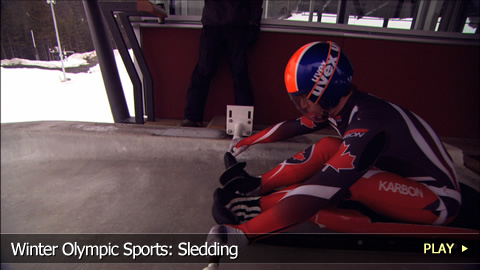Winter Olympic Sports: Sledding

Bobsled
An Olympic event since the first winter games in 1924, bobsled involves a team of racers sitting in an aerodynamic sleigh, descending down an icy track. In this timed event, athletes must push the sled to a competitive speed before jumping into a seated position for the remainder of the run. Today it is either a two-or four-person event, with one pilot who steers, and one rider who commands the brakes. The sled’s speed is dependent on the condition of the ice, weight of the sled, as well as the pilot’s talent for precise driving. Races are often won by hundredths of a second, and so any mistake can significantly alter the outcome of a run. Mistakes near the beginning of a run are especially taxing, because they can potentially decrease the speed of the sled for the remainder of the track.
Luge
Introduced to the Olympics at the 1964 Innsbruck games, the luge has racers lying face-up on an open sled down an iced track. Speeds in the sport can reach almost 90 miles or 140 kilometers per hour. As in bobsled, the beginning of the race is crucial. Starting out seated, but quickly changing to as aerodynamic a position as possible, lugers steer with their legs and shoulders. It is competed as either a singles or doubles event.
Skeleton
Skeleton is comparable to the luge, however instead of laying supine on the sled, competitors race head-first down the track. Similar to the other sledding sports, these athletes must run as quickly as possible at the beginning of the race to gain momentum. Skeleton racers must then dive head-first onto their sled and run the race on their stomachs, shifting slightly to steer. No braking equipment is permitted, and speeds reach up to 80 miles or 130 kilometers per hour. The sport has gained popularity due to the success of amateurs at an Olympic level. The event appeared at both the 1928 and 1948 Winter Olympic Games, and was finally reintroduced in Salt Lake City in 2002. For their incredible speed, Olympic sledding sports are always an exciting spectacle.

